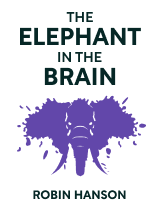

This article is an excerpt from the Shortform book guide to "The Elephant in the Brain" by Robin Hanson and Kevin Simler. Shortform has the world's best summaries and analyses of books you should be reading.
Like this article? Sign up for a free trial here .
Do doctors actually care about you? Why do people buy Teslas? What’s the hidden purpose of education?
In The Elephant in the Brain: Hidden Motives in Everyday Life, Kevin Simler and Robin Hanson argue that human behavior is driven by selfish motives hidden behind altruistic pretexts. They argue that, because we’re a cooperative social species, our brains evolved to hide our true motives not just from others, but from ourselves so as to balance our selfishness with our need to get along.
Keep reading for an overview of the book.
The Elephant in the Brain: Overview
Simler and Hanson call selfish motives “the elephant in the brain” because, like the metaphorical “elephant in the room,” they’re a large, unavoidable problem that nobody wants to acknowledge. And the elephant doesn’t affect us just as individuals—it shows up in institutions such as education, health care, and religion.
Therefore, Simler and Hanson say that, if we learn to recognize the elephant, we can improve ourselves by being less selfish or by turning our self-interest toward better ends. Moreover, without understanding the real motives driving our social systems, we stand little chance of reforming these systems to better achieve their intended goals.
Published in 2018, The Elephant in the Brain: Hidden Motives in Everyday Life emerged when Simler (a software engineer and blogger) approached Hanson (an economics professor) about forming an informal student-advisor relationship. The authors describe the resulting book as a doctoral thesis written for a general audience instead of a dissertation committee. Together, they draw on research from evolutionary biology, sociology, and psychology to advance their arguments. They acknowledge that their core idea—humans are selfish but pretend not to be—isn’t original, but argue that their application of this idea to large-scale social systems is. (Shortform note: In addition to his work in economics, Hanson is also known for his controversial social views.)
First, we talk about why we have hidden motives in the first place. Then we explore several areas in which these motives manifest—our communications; our use of money and other resources; and our social institutions such as health care, education, and religion. Finally, we discuss a few ways we can use our knowledge of hidden motives to improve our lives.
Part 1: Where Hidden Motives Come From
At first glance, the idea of hidden motives may seem convoluted—why hide our true intentions not just from others, but from ourselves? The answer, according to Simler and Hanson, is that as a cooperative social species, we evolved to advance our own interests while appearing as selfless as possible—and it’s easier to deceive others if we’ve already deceived ourselves. In this section, we’ll explore how human life is organized around a set of social games and how our hidden motives help us get ahead in these games.
We Excel at Social Games
Simler and Hanson believe hidden motives are an evolutionary adaptation. They argue that the human brain evolved to excel simultaneously at selfishness and cooperation. Because of the tension between selfishness and altruism, Simler and Hanson argue that the human brain evolved to play social games—competitions that require balancing self-interest with cooperation.
Social games typically revolve around three main goals: sex, social status, and politics. Simler and Hanson argue that social games require two main skills: the ability to attract good partners (mates, friends, allies) and to judge potential partners.
We Cheat at Social Games
Simler and Hanson emphasize that social games are competitive and not everyone can win. To maximize our chances, they say, we’ve evolved the skills needed not just to play these games, but also to cheat at them. To see how, we need to understand how norms regulate our social games and how we can get the upper hand by evading these norms.
Social Games Are Governed by Norms
Human cultures regulate selfish behavior and competition with norms—which are the rules and standards of a society. Sometimes they’re codified as laws and enforced centrally, but most often, norms are collectively enforced by the group as a whole. In short, norms teach us to regulate each other and to punish unwanted behavior with consequences ranging from eye rolls to gossiping to open violence. Perhaps more to the point, norms teach us to regulate ourselves.
Deception Lets Us Skirt Norms
Because norms evolved as a way to enforce pro-social behaviors like cooperation, sharing, and non-violence, our selfish motivations are at odds with the norms that govern us. But, rather than making humans less inherently selfish, Simler and Hanson say that norms led humans to evolve ways to advance our selfish motivations while appearing to adhere to social standards. In other words, we’ve developed a whole range of strategies for avoiding norm enforcement so that we can get away with “cheating” at our social games. These strategies include pretexts (socially acceptable reasons), discretion (avoiding openly stating our intentions), and toeing the line (testing the boundaries of norms).
Part 2: Hidden Motives in Daily Life
Hidden motives may have evolved when humans still lived in small foraging societies, but, according to Simler and Hanson, this phenomenon is now hard-wired into our brains. As a result, they say that hidden motives affect most aspects of our daily lives, from our interactions to our behaviors to our social institutions. In this section, we’ll explore how our communication is rife with hidden messages, how we use spending (and giving) to signal status, and how our social institutions are built around wholly different goals than the ones we admit to.

———End of Preview———
Like what you just read? Read the rest of the world's best book summary and analysis of Robin Hanson and Kevin Simler's "The Elephant in the Brain" at Shortform .
Here's what you'll find in our full The Elephant in the Brain summary :
- How human behavior is driven by selfish motives
- Why your own brain is hiding your intentions from you
- Why the purpose of education is to certify future employees






